Please go to: 2008-12-20 Lockheed Martin changed its website to say that it does not manufacture cluster munitions
I copied evidence here as a back-up copy. But the information didn’t copy very well. Best to go to 2008-12-20.
| Directory of U.S. Military Rockets and Missiles Appendix 5: Guided Bombs |
| WCMD |
| Copyright © 2006 Andreas Parsch |
Lockheed Martin WCMD (Wind Corrected Munitions Dispenser)
(CBU-103/B, CBU-104/B, CBU-105/B, CBU-107/B, CBU-113/B, CBU-115/B)
WCMD (Wind Corrected Munitions Dispenser) is a modification kit to equip submunition dispensers of the TMD (Tactical Munitions Despenser) family (SUU-64/B, SUU-65/B and SUU-66/B) with a guidance system. Development began in the 1995/96 time frame, and low-rate production by Lockheed Martin started in 1998. In 2000, WCMD was declared ready for operational use (on B-52 and F-16 aircraft), and in 2001 full-rate production began. More than 10000 WCMD kits have been delivered so far, and the U.S. Air Force has a requirement for up to 40000 units.
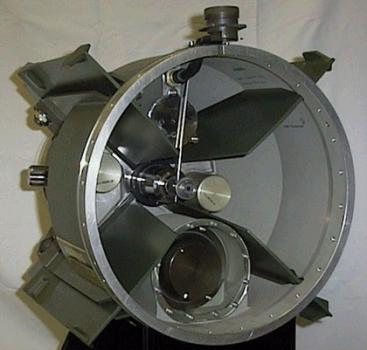 |
| Photo: Lockheed Martin |
| WCMD tail kit |
The WCMD guidance kit can replace the tail of any TMD-based cluster bomb. The baseline WCMD incorporates an inertial navigation system (INS), and has flip-out control fins to steer the bomb. Additional GPS guidance was considered unnecessary, because the delivery aircraft are equipped with a GPS system. The latter is used to update the WCMD‘s INS immediately before release, and the resulting accuracy of about 26 m (85 ft) CEP is good enough for cluster bombs. After release, the WCMD guidance corrects for launch errors and winds aloft, and computes the optimum flight path and submunition release point. When dropped from 12200 m (40000 ft), a WCMD guided cluster bomb has a stand-off range of about 16 km (10 miles).
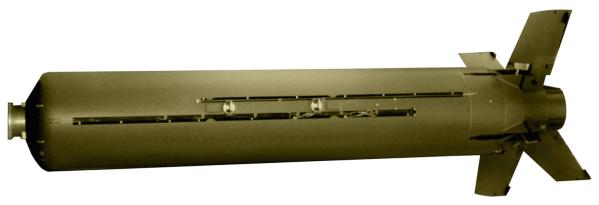 |
| Photo: Lockheed Martin |
| WCMD |
The following cluster munitions have been cleared for use with a WCMD tailkit:
- CBU-87/B CEM (Combined Effects Munition): 430 kg (950 lb) multi-purpose cluster bomb, consisting of 202 1.5 kg (3.4 lb) BLU-97/B CEBs (Combined Effects Bomblets) in an SUU-65/B dispenser. After release, each BLU-97/B descends under a cone-shaped decelerator and detonates on ground impact. A CEB has a triple charge, incorporating a fragmenting case against soft targets, an anti-armour shaped charge, and an incendiary device.
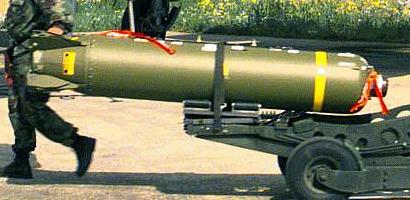
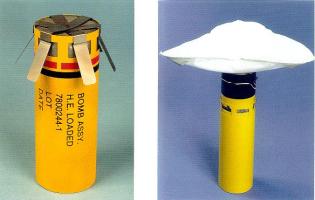
Photos: via GlobalSecurity.org CBU-87/B BLU-97/B - CBU-89/B “Gator”: 320 kg (700 lb) anti-personnel/anti-tank cluster bomb, consisting of 72 2 kg (4.3 lb) BLU-91/B anti-tank and 22 1.7 kg (3.7 lb) BLU-92/B anti-personnel mines in an SUU-64/B dispenser. Both submunition types are armed on ground contact. The BLU-91/B is detonated by a magnetic influence fuze, and the BLU-92/B by four trip wires.
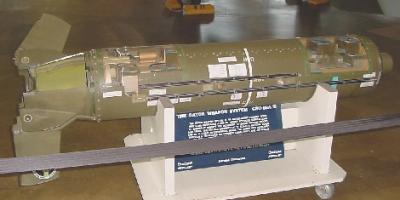
Photo: Hill Aerospace Museum CBU-89A/B - CBU-97/B SFW (Sensor Fused Weapon): 415 kg (914 lb) anti-tank cluster bomb, consisting of 10 BLU-108/B in an SUU-66/B dispenser. A BLU-108/B unit carries four independent Skeet anti-tank submunitions. After release from the dispenser, each BLU-108/B descends under a parachute to a pre-set altitude. Then a small rocket sends the BLU-108/B upwards and into a rapid spin, so that the Skeet warheads are released outwards. Each Skeet falls independently, scanning the ground with its IR sensor for the signature of a tank. When a target is detected, the Skeet detonates, firing an EFP (Explosively Formed Penetrator) directly downward, and a ring of fragments outwards (against soft targets in the vicinity). If no target is detected, the Skeet explodes immediately above the ground.
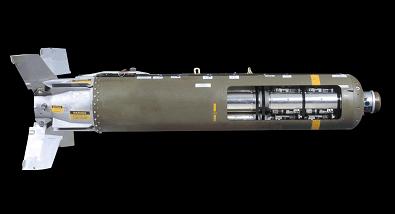
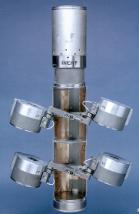
Photos: Textron Systems CBU-97/B BLU-108/B - PAW (Passive Attack Weapon): 1000 lb class cluster bomb with 3750 non-explosive penetrator rods in an SUU-66/B dispenser. This weapon was developed within three months in late 2002 to destroy soft area targets (like e.g. fuel storage depots) with a minimum of collateral damage.
When fitted with a WCMD guidance kit, these CBUs receive new designations. As guided cluster munitions, WCMD weapons qualify for both the GBU (guided bomb) and CBU (cluster bomb) categories, and the USAF decided to designate them in the latter. The following table lists all known WCMD-equipped cluster bombs:
| Designation | Base CBU | Payload |
| CBU-103/B | CBU-87/B | 202x BLU-97/B in SUU-65/B |
| CBU-103A/B | CBU-87A/B 1 | |
| CBU-103B/B | CBU-87B/B | 202x BLU-97A/B 2 in SUU-65/B |
| CBU-104/B | CBU-89/B | 72x BLU-91/B + 22x BLU-92/B in SUU-64/B |
| CBU-104A/B | CBU-89A/B 3 | |
| CBU-105/B | CBU-97/B | 10x BLU-108/B in SUU-66/B |
| CBU-105A/B | CBU-97A/B | 10x BLU-108A/B 4 in SUU-66/B |
| CBU-105B/B | CBU-97B/B | 10x BLU-108B/B 4 in SUU-66/B |
| CBU-105C/B | CBU-97C/B | 10x BLU-108C/B 4 in SUU-66/B |
| CBU-107/B | — 5 | 3750 non-explosive penetrator rods in SUU-66/B |
Notes:
- Details about the differences between the CBU-87/B and -87A/B are not available.
- Details about the differences between the BLU-97/B and -97A/B are not available.
- Details about the differences between the CBU-89/B and -89A/B are not available.
- The BLU-108A/B has a different SAD (Safety & Arming Device). The BLU-108B/B is the P3I (Preplanned Product Improvement) version, which features improved performance against countermeasures, increased footprint because of Skeet release at higher altitude, amd Skeet submunitions with a dual mode (active/passive) sensor and a redesigned multi-mission warhead. The BLU-108C/B was an interim upgrade of the BLU-108A/B because of delays in the P3I program, and had modified Skeet warheads with insensitive munitions filling.
- There is no non-WCMD version of the CBU-107/B.
The CBU-103/B and CBU-105/B have been used operationally for the first time during the war in Afghanistan in 2001, and the CBU-107/B was used in combat in Iraq in 2003.
WCMD-ER
In June 2003, Lockheed Martin received a contract to develop and test the WCMD-ER extended range version of the WCMD guidance kit. WCMD-ER adds a wing kit to increase stand-off range to 40-65 km (30-40 miles), as well as additional GPS guidance to maintain WCMD‘s accuracy. In May 2005, Lockheed Martin started low-rate production of WCMD-ER kits for the CBU-97/B SFW.
When fitted with a WCMD-ER guidance kit, the Combined Effects Munition (CBU-87/B) is designated in the CBU-113/B series, while the Sensor Fused Weapon (CBU-97/B) is designated in the CBU-115/B series. At the time of this writing, the only weapon actually planned for WCMD-ER is the CBU-97B/B, which will probably result in a CBU-115B/B designation. The CBU-114/B designation was probably either skipped or formally assigned to a WCMD-ER equipped “Gator” (CBU-89/B), but the “Gator” is being phased out by the USAF and therefore won’t be fitted with WCMD-ER.
Designation note: CBU numbers 108 through 112 are apparently unassigned so far. Therefore it appears that the WCMD-ER CBU designators were assigned out-of-sequence to implement an easy to remember scheme, where CBU-11x/B (WCMD-ER) corresponds to CBU-10x/B (baseline WCMD).
Specifications
Note: Data given by several sources show slight variations. Figures given below may therefore be inaccurate!
Data for WCMD dispenser:
| Length | 2.34 m (7 ft 8 in) |
| Diameter | 40.6 cm (16 in) |
Main Sources
[1] GlobalSecurity.org Website
[2] Lockheed Martin Missiles & Fire Control Website
Back to Directory of U.S. Military Rockets and Missiles, Appendix 5
Last Updated: 15 May 2006